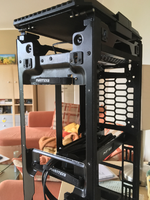Navigation
Install the app
How to install the app on iOS
Follow along with the video below to see how to install our site as a web app on your home screen.
Note: This feature may not be available in some browsers.
More options
You are using an out of date browser. It may not display this or other websites correctly.
You should upgrade or use an alternative browser.
You should upgrade or use an alternative browser.
NCASE M1 vs. Phanteks Shift
- Thread starter einmannbude
- Start date
Dan
Supreme [H]ardness
- Joined
- May 23, 2012
- Messages
- 8,020
Well, My shift build is done. Ive run the bench marks, Ive rebuilt it 2 times due to figuring out better build solutions as i went... What a fucking case to build it. Honestly 1.5-2h easy. It tooks forever to get done right but OMFG this case is beautiful. Very tight spacing especially with SFX short cables. I was able to make it work but by a HAIR.
Ryzen 1700
Gigabyte b350 ITX. This board layout is very different then all other ITX boards. the 24 pin and 8 pin JUST reach
GTX 1080 FE
16GB Gskill 3000
Corsair SFX 450w Gold
1x 2tb 7200
2x 256 SSD
2x Phanteks rgb things
1x Phanteks Halo 140 mm ring
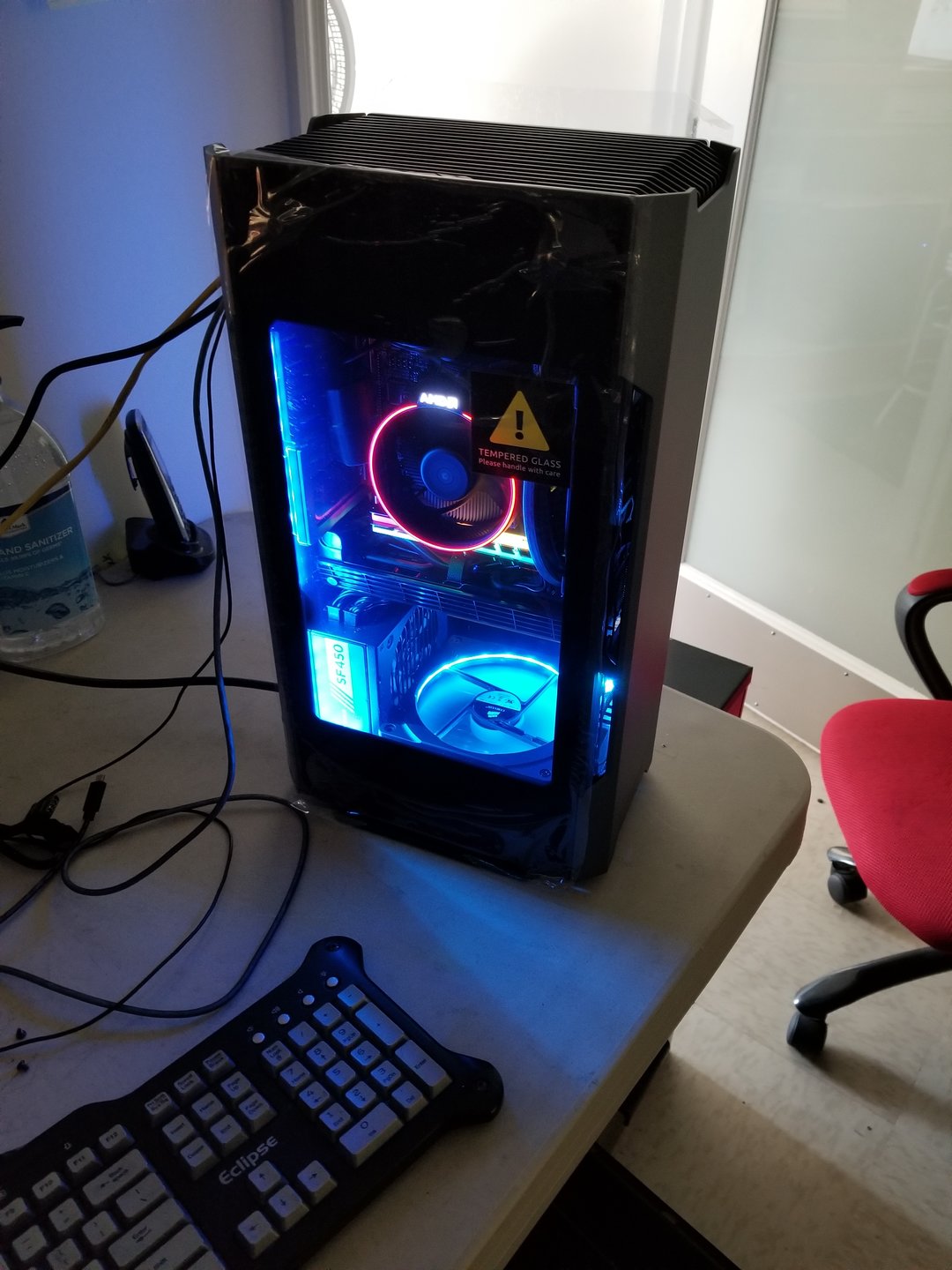
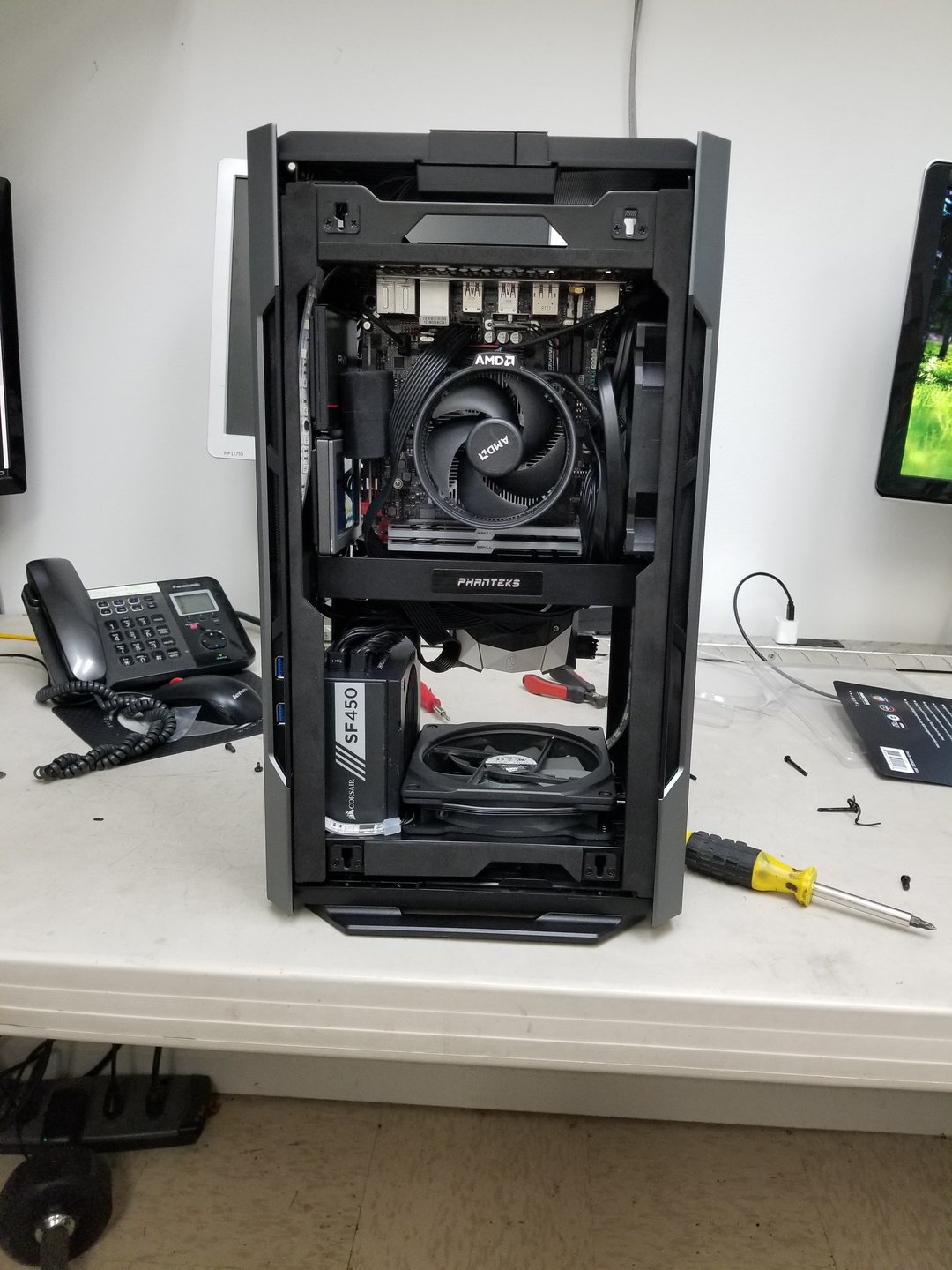
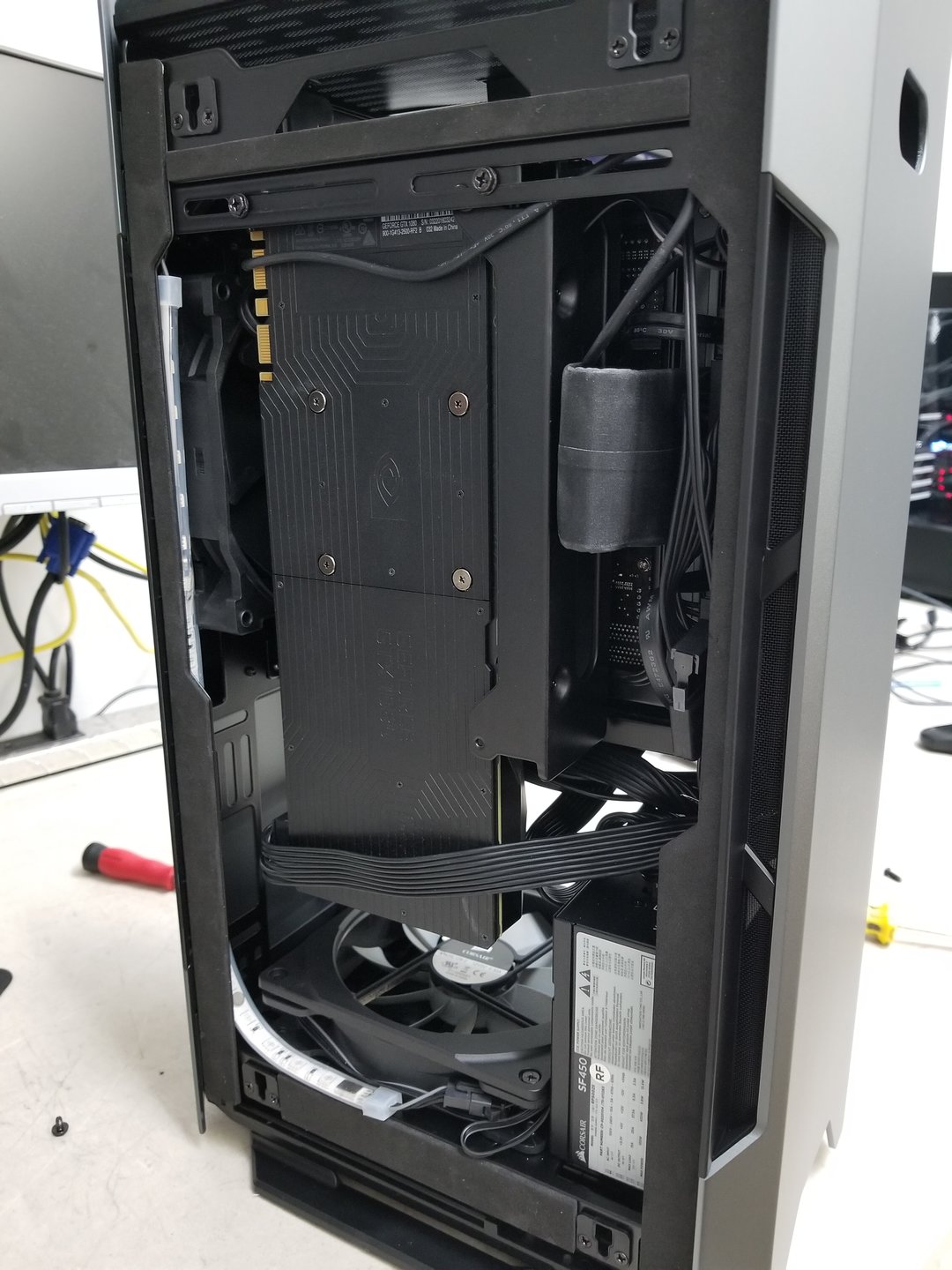
Ryzen 1700
Gigabyte b350 ITX. This board layout is very different then all other ITX boards. the 24 pin and 8 pin JUST reach
GTX 1080 FE
16GB Gskill 3000
Corsair SFX 450w Gold
1x 2tb 7200
2x 256 SSD
2x Phanteks rgb things
1x Phanteks Halo 140 mm ring



I was able to get the following into the bottom compartment with no mods:

Here’s another photo where the parts would fit, but fittings would interfere with the reservoir. Note that the pump and reservoir combo are mounted on the bottom fan:

- Silverstone SX-600. I was able to mount this with fan facing out. (no photo - interference between the two cord strain relieves area. I almost started to shaved off the strain relieve plastic when I decided to try the low profile extension cord from my NCase M1. Fits now)
- Bottom radiator - 120mm 26mm slim radiator (EK SE)
- Front radiator - 120mm 30mm slim radiator (XSPC)
- 2x120mm 25mm thick fans set to intake
- EK DDC pump with reservoir

Here’s another photo where the parts would fit, but fittings would interfere with the reservoir. Note that the pump and reservoir combo are mounted on the bottom fan:

einmannbude
Limp Gawd
- Joined
- Aug 16, 2014
- Messages
- 128
Thanks for the update. Sounds complicated.
It turned out that I ordered only one 120mm radiator instead of two by accident. Now I have to wait for the second to deliver before I can go on. I did cut the PSU support bridge and this one bridge in the middle of the bottom in the mean time. Will report when all parts arrived.
It turned out that I ordered only one 120mm radiator instead of two by accident. Now I have to wait for the second to deliver before I can go on. I did cut the PSU support bridge and this one bridge in the middle of the bottom in the mean time. Will report when all parts arrived.
Boil
[H]ard|Gawd
- Joined
- Sep 19, 2015
- Messages
- 1,439
Front radiator - 120mm 30mm slim radiator (XSPC)
Will your GPU still fit with the (slightly) thicker than spec front radiator...?
Hmm I’ll check tonight. I have a FE. Will be bummed if it doesn’t.Will your GPU still fit with the (slightly) thicker than spec front radiator...?
I did test performance of the pcie extender in a different system. It works well.
rfarmer
[H]ard|Gawd
- Joined
- May 9, 2014
- Messages
- 1,169
Doh you’re right. It doesn’t fit with the thicker rad. :/ Problem solving mode.
Oh man that sucks, after doing such a great job fitting all that in there.
Boil
[H]ard|Gawd
- Joined
- Sep 19, 2015
- Messages
- 1,439
Doh you’re right. It doesn’t fit with the thicker rad. :/ Problem solving mode.
That is why the manufacturer specs 27mm maximum for radiators (assuming 25mm thick fans are used) in this system...
You could go with a 15mm thick fan...
I would just go with a 120mm AIO for the CPU & a Hybrid GPU (w/ 120mm AIO) for this chassis...
That would leave the 'central mass' area open for airflow to the single 140mm exhaust fan...
Well, switching my blocks to 2x Corsair H75 AIO would work for sure... but I would like to keep using the monoblock and GPU block.
On the reference length graphics card, the 8 pin power connector interferes with either the fan or the PSU. I would need to get a low profile 90 degree adapter / connector for the 8 pin. If only my 1080 were a mini version. This would fit easier.
Edit: I was able to squeeze these together:

I just need to figure out soft tubing routing.
On the reference length graphics card, the 8 pin power connector interferes with either the fan or the PSU. I would need to get a low profile 90 degree adapter / connector for the 8 pin. If only my 1080 were a mini version. This would fit easier.
Edit: I was able to squeeze these together:

I just need to figure out soft tubing routing.
Last edited:
Boil
[H]ard|Gawd
- Joined
- Sep 19, 2015
- Messages
- 1,439
Looking good...!
Please make sure you let us know what temps you are seeing (CPU, GPU, M.2 SSD; at idle & under load, stuff like that) & noise levels as well...
Interested to see how the intakes work out (bottom seems like it would be okay, but front has limited venting, same for exhaust, limited venting there as well)...
Please make sure you let us know what temps you are seeing (CPU, GPU, M.2 SSD; at idle & under load, stuff like that) & noise levels as well...
Interested to see how the intakes work out (bottom seems like it would be okay, but front has limited venting, same for exhaust, limited venting there as well)...
Here’s the build in action.
Loop order
D5 pump - bottom 120mm x 26mm radiator - front 120mm x 30mm radiator - GTX1080 (no OC) - 6700K (5% auto OC) - QDC (removable reservoir) - D5 pump
Airflow
ML 140 exhuast
2x EK F4 Vardar intake
passive exhaust up top and rear
Temperatures and sound while,
The 850 SSD drive hovers around 40-50c
The fans can be loud if I increase the radiator fans RPM beyond 2000 (front bottom fan blade interference with fan frame due to D5 vibration - need to address this)
Overall I’m happy with this build. Given that there is only 240mm of radiator, and crowded case, I wouldn’t expect cpu temperatures to get much better.

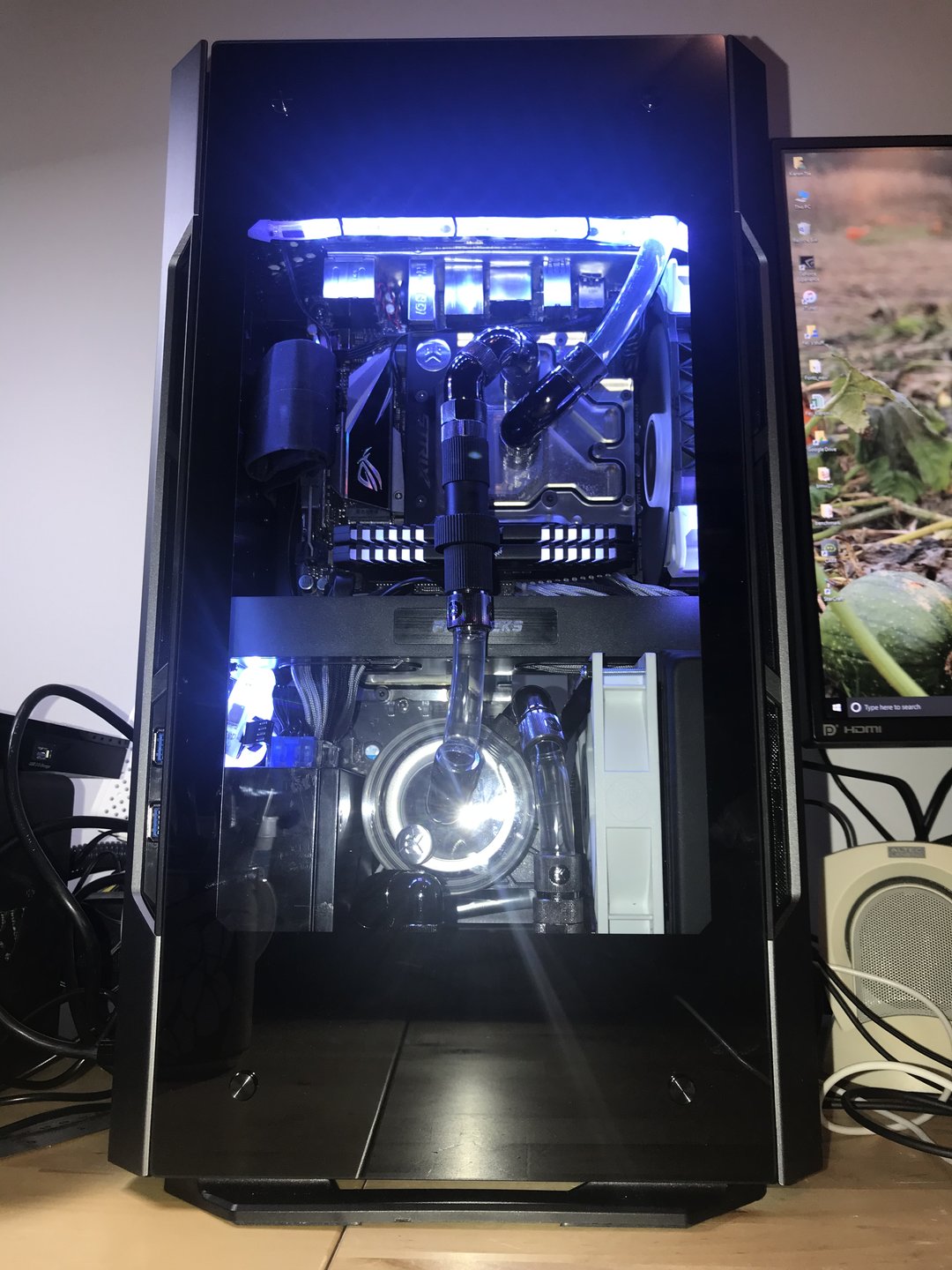
Loop order
D5 pump - bottom 120mm x 26mm radiator - front 120mm x 30mm radiator - GTX1080 (no OC) - 6700K (5% auto OC) - QDC (removable reservoir) - D5 pump
Airflow
ML 140 exhuast
2x EK F4 Vardar intake
passive exhaust up top and rear
Temperatures and sound while,
- Idle
- CPU ~30c
- GPU ~40c
- Gaming
- CPU ~55c
- GPU ~50c
- Coolant ~ 42c
- silent
- Keyshot rendering
- CPU ~66c
- GPU ~45c
- Coolant ~ 42c
- relatively quiet
- radiator fans ~1976rpm
- pump ~4700rpm
- exhaust ~1486rpm
- Prime 95 (15 minutes)
- CPU ~75c (and rising)
- GPU ~48c
- Coolant ~45c
- relatively quiet
- radiator fans ~1976rpm
- pump ~4700rpm
- exhaust ~1486rpm
The 850 SSD drive hovers around 40-50c
The fans can be loud if I increase the radiator fans RPM beyond 2000 (front bottom fan blade interference with fan frame due to D5 vibration - need to address this)
Overall I’m happy with this build. Given that there is only 240mm of radiator, and crowded case, I wouldn’t expect cpu temperatures to get much better.


Last edited:
einmannbude
Limp Gawd
- Joined
- Aug 16, 2014
- Messages
- 128
My second radiator arrived. And I ordered a new Magicool DCP-450 to be able to fit everything without taking my current rig apart. Unfortunately it turned out, that this Magicool unit is not 125mm in height like the package and spec says, but 140mm. This means, I can't stack the radiator, fan and pump/res in the bottom. I can either have a fan or a radiator in the bottom. Now I am thinking about possibilities. While reading, keep in mind, that I want to air-cool the CPU with a top-down cooler.
- Different pump. Not really an option. I recently tested the EK SPC pump again while planning this build. It is already audible when running above 35% speed. Magicool runs inaudible at full speed.
- Bottom radiator, no bottom fan, lower front radiator with fan as exhaust. Would hopefully pull enough air through the bottom radiator passively. But not sure about that.
- Bottom fan as intake, no bottom radiator, lower front radiator (maybe with fan - unsure about orientation), upper front radiator instead of fan, maybe modding the upper back to host another radiator. In my imagination the CPU fan would blow towards the board and the air would then escape through the front and back radiators. I would maybe seal the top. Unsure about how good this setup would work. If I had to run the fans with high RPM to get decent cooling performance, this would work against my silent approach. On the other hand there would be 3x 120mm radiator space for the GPU alone. Too many variables, too less experience.
Sorry to hear the parts aren’t fitting as planned. That seem to be the theme with my build as well. I did manage to fit everything in, but now I’m dealing with thermals during 1 hour gaming session. (No OC, but GPU hits 65 and up, and cpu reaches 70 and up. Coolant temps got to 59c when I killed the game. I haven’t had time to see if temps will keep rising until thermal-throttling or if temps will stabilize at some point. Or if the tubing and pumps are going to start breaking down... my earlier tests were 10-15 minutes and they seem ok until the setup gets heatsoaked.
Few conclusions, in lieu of having direct responses to your question:
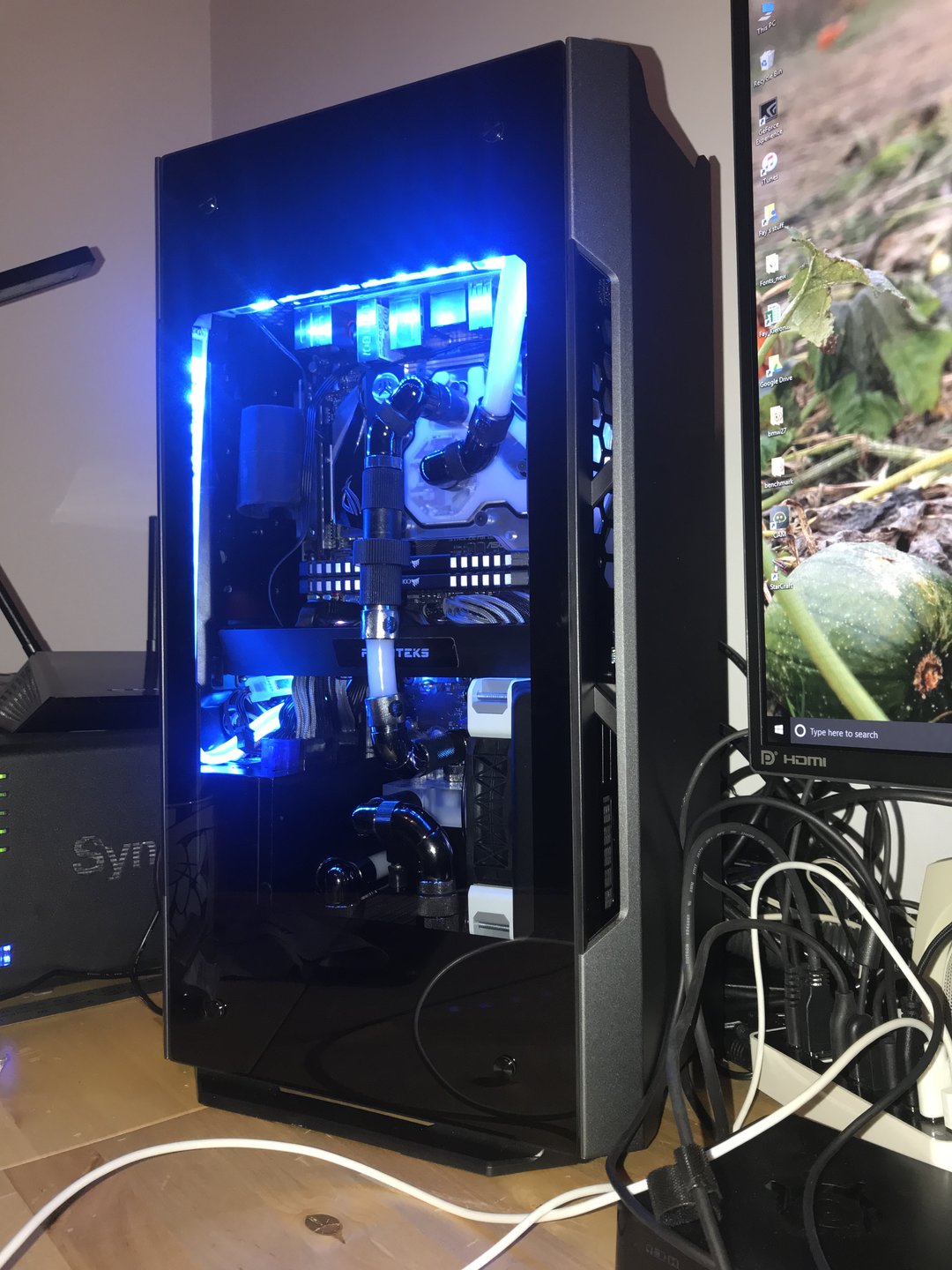 Sorry for the messy cables.
Sorry for the messy cables.
Few conclusions, in lieu of having direct responses to your question:
- My D5 was mounted to the front fan, but when the front fan goes beyond 2000rpm, the blade starts scrapping. I couldn’t see anything interfering with fan blades. Not sure if the weight of the D5 is ovalizing the fan housing.I think cooling both cpu and GPU in the same loop may be a mistake in this case?
- I find that the bottom location is way too restrictive. I’ve tried removing all filters, and it still seem to run warm.
- Having both bottom and bottom front blowing hot air into the case seem to trap the hot air in the bottom, and cooks the pump.
- I’ve switch the D5 out for a DDC to have less stuff / more space in the bottom area. DDC mounts to the bottom fan. No more scrapping. DDC noise not bothering me.
- Tried setting bottom front fan to exhaust. No real difference yet.
- I notice the case passively emitting warm air through all of the vents.
- Not sure what to try next. Maybe one of your ideas to have another heat exchange radiator instead of the upper fan)

Boil
[H]ard|Gawd
- Joined
- Sep 19, 2015
- Messages
- 1,439
The Shift is designed for dual 120mm AIOs, one on the CPU & one on the GPU (Hybrid GPU)...
The Shift XL (which I do not like because it is so tall) is the chassis designed to fit a custom loop...
I believe it would allow a 280mm radiator & a D5-based pump / reservoir combo...
The Shift XL (which I do not like because it is so tall) is the chassis designed to fit a custom loop...
I believe it would allow a 280mm radiator & a D5-based pump / reservoir combo...
I understand what the Shift was designed for. If I used separate AIOs, I know I would not get better thermals. I’ve done dual 120mm AIOs before on my NCase build, and thermals were similar to dual 120mm single custom loop that I’m currently getting. It’s just the restrictive airflow - seems to be a common thing across all of the Evolv line.The Shift is designed for dual 120mm AIOs, one on the CPU & one on the GPU (Hybrid GPU)...
The Shift XL (which I do not like because it is so tall) is the chassis designed to fit a custom loop...
I believe it would allow a 280mm radiator & a D5-based pump / reservoir combo...
Boil
[H]ard|Gawd
- Joined
- Sep 19, 2015
- Messages
- 1,439
I understand what the Shift was designed for. If I used separate AIOs, I know I would not get better thermals. I’ve done dual 120mm AIOs before on my NCase build, and thermals were similar to dual 120mm single custom loop that I’m currently getting. It’s just the restrictive airflow - seems to be a common thing across all of the Evolv line.
Yeah, that is what bothers me the most, the restrictive intakes (more the front intake, the bottom has a bit more, but is still not as open as I would like to see) & the restrictive exhaust...
I really don't count the top exhaust as providing much actual exhaust, it is passive & most of that area is filled with the I/O areas for the motherboard & the GPU...
To keep on track with the original theme of the thread, I am still bouncing back & forth between Shift with dual AIOs or NCASE M1 with full custom loop...
Wallet & cheesy eye candy lean towards the former, 'ultimate' SFF ITX workstation leans towards the latter...
There there is the question of i7 8700K or non-K; K would allow faster RAM (3200/14 versus 2666/13), non-K might run a bit cooler...?
Either way I wouldn't be overclocking the CPU or GPU, just letting the CPU turbo up on its own & letting the GPU do its own stock OC/boost thing...
GPU would be the (as yet unreleased) GTX 1070 Ti...
I dunno...
rfarmer
[H]ard|Gawd
- Joined
- May 9, 2014
- Messages
- 1,169
Yeah, that is what bothers me the most, the restrictive intakes (more the front intake, the bottom has a bit more, but is still not as open as I would like to see) & the restrictive exhaust...
I really don't count the top exhaust as providing much actual exhaust, it is passive & most of that area is filled with the I/O areas for the motherboard & the GPU...
To keep on track with the original theme of the thread, I am still bouncing back & forth between Shift with dual AIOs or NCASE M1 with full custom loop...
Wallet & cheesy eye candy lean towards the former, 'ultimate' SFF ITX workstation leans towards the latter...
There there is the question of i7 8700K or non-K; K would allow faster RAM (3200/14 versus 2666/13), non-K might run a bit cooler...?
Either way I wouldn't be overclocking the CPU or GPU, just letting the CPU turbo up on its own & letting the GPU do its own stock OC/boost thing...
GPU would be the (as yet unreleased) GTX 1070 Ti...
I dunno...
Yeah the non k 8700 might only have a base clock of 3.2 GHz but it's boost clock is all the way up to 4.6 GHz, with a boost like that you wouldn't need an overclock. Only 65watt too.
The bottom intake on the Shift isn’t all that great once the base and panels are installed. I’ll probably tinker a bit more and run some tests to see if I can keep the cpu under 70c.
Well back to the original topic, for thermals, my first hand experience is that NCase M1 is winner.
With CPU air-cooling, the M1 being to accommodate a modest tower cpu heatsink, or a large top-down heatsink, beats the Shift’s 82mm cpu heatsink clearance.
For GPU air-cooling, the M1 graphics card has access to the bottom vents, and a third slot for added GPU cooling flexibility.
For AIO (2x 120mm), both the M1 and Shift perform similarly.
For custom loop, the M1 has more flexibility in terms of loop configurations.
Well back to the original topic, for thermals, my first hand experience is that NCase M1 is winner.
With CPU air-cooling, the M1 being to accommodate a modest tower cpu heatsink, or a large top-down heatsink, beats the Shift’s 82mm cpu heatsink clearance.
For GPU air-cooling, the M1 graphics card has access to the bottom vents, and a third slot for added GPU cooling flexibility.
For AIO (2x 120mm), both the M1 and Shift perform similarly.
For custom loop, the M1 has more flexibility in terms of loop configurations.
Boil
[H]ard|Gawd
- Joined
- Sep 19, 2015
- Messages
- 1,439
For AIO (2x 120mm), both the M1 and Shift perform similarly.
I would think the M1 would have better surface area in regards to ventilation I/O, but the two sets of AIO hoses would clog up the airflow path from input on the side panel to output at the top venting...
One of the reasons I would feel compelled to do a full custom loop in the M1...!
I flashed on the original Exorcist movie, and the line "The power of Christ compels you!"...
Now I wonder if getting my cooling fluid blessed by a priest to make it Holy Water might help...
Gotta be good for a few degrees, yeah...?!?
rfarmer
[H]ard|Gawd
- Joined
- May 9, 2014
- Messages
- 1,169
I would think the M1 would have better surface area in regards to ventilation I/O, but the two sets of AIO hoses would clog up the airflow path from input on the side panel to output at the top venting...
One of the reasons I would feel compelled to do a full custom loop in the M1...!
I flashed on the original Exorcist movie, and the line "The power of Christ compels you!"...
Now I wonder if getting my cooling fluid blessed by a priest to make it Holy Water might help...
Gotta be good for a few degrees, yeah...?!?
lol, can't hurt.
einmannbude
Limp Gawd
- Joined
- Aug 16, 2014
- Messages
- 128
I am sorry to hear that. I thought a 140mm fan in the upper top would suck enough air out of the case. Then it might not be a good idea to remove this fan and replace it with a radiator.Having both bottom and bottom front blowing hot air into the case seem to trap the hot air in the bottom, and cooks the pump.
Some pumps aren't designed to operate beyond a certain temp (I think my SPC pump is limited to 45C). The D5 is good up to 60C IIRC, although my D5 equipped system has the coolest water temp out of all my systems, go figure, so haven't looked at this number in a long while. Optimal water temp is between 30-40; this is hard to do in an M1, let alone the Shift, so I think temps in the mid 40s plus are likely common. At 59C... well, you're still cooling, but not that well.
I haven't seen the Shift in person yet. Is the top panel detatchable? I know it swings open. I'd like to see if the temps drop much with the top swung open. Do you have any photos of the top head-on? I'm not clear from the what I've seen what kind of airflow options there are up there.
I haven't seen the Shift in person yet. Is the top panel detatchable? I know it swings open. I'd like to see if the temps drop much with the top swung open. Do you have any photos of the top head-on? I'm not clear from the what I've seen what kind of airflow options there are up there.
einmannbude
Limp Gawd
- Joined
- Aug 16, 2014
- Messages
- 128
Here are some pictures of the top. There is not much surface area of ventilation. Nevertheless, I already had the idea of somehow integrate a slim fan in the top to push fresh air inside the case from top in addition to the bottom. So air is forced to escape to the sides, where I want to install radiators.Do you have any photos of the top head-on?
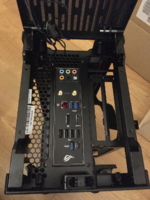

Last edited:
I hope your magicool radiators will perform better than mine.Here are some pictures of the top. There is not much surface area of ventilation. Nevertheless, I already had the idea of somehow integrate a slim fan in the top to push fresh air inside the case from top in addition to the bottom. So air is forced to escape to the sides, where I want to install radiators.
View attachment 38776 View attachment 38777
I thought about adding a slim 120 or 92 fan to the top cover as well, but I think the I/O shield and cables are too restrictive to make a difference. I’m considering switching the CPU to air, and keep GPU under water. I play games more than perform CPU core-intensive tasks on my home machine, so I’d prioritize cooling the GPU so that it won’t won’t thermal throttle.
Here are some pictures of the top. There is not much surface area of ventilation. Nevertheless, I already had the idea of somehow integrate a slim fan in the top to push fresh air inside the case from top in addition to the bottom. So air is forced to escape to the sides, where I want to install radiators.
View attachment 38776 View attachment 38777
Yeah, if there's enough room for something like the a12x15, then that could definitely help. That mesh Phanteks uses is very restrictive. I don't know if removing it is an option, but I did that on my Evolv ATX and pretty much doubled my airflow out the top.
So, if I'm understanding right, top and bottom as intakes, sides through radiators as exhaust? I ended up going exhaust on the M1 and getting another two-three degrees knocked off water temps, just have to blow it out once a month.
Hmm... that's a decent sized area next to the motherboard for some ducting options maybe... wouldn't be pretty though.
einmannbude
Limp Gawd
- Joined
- Aug 16, 2014
- Messages
- 128
I am curious as wellMy upper back can now house a 120mm radiator. I also already cut some holder brackets to length. Still have to drill holes for the screws in there.
I am curious like a child how this project ends.
View attachment 38863
Yeah, same problem, to a lesser to degree, as the Evolv ATX TG. If one of those panels was vented instead of glass, would make a noticeable difference for temps.
Is the glass detachable from the mounting brackets? I'd be curious if you could offset the glass from the bracket so it's not flush with the sides, creating more ventilation. Kind of like how Corsair has it's pop-up panels for their all glass cases.
Is the glass detachable from the mounting brackets? I'd be curious if you could offset the glass from the bracket so it's not flush with the sides, creating more ventilation. Kind of like how Corsair has it's pop-up panels for their all glass cases.
einmannbude
Limp Gawd
- Joined
- Aug 16, 2014
- Messages
- 128
This is how far I have come. PSU is not mounted, that's why it is not aligned.
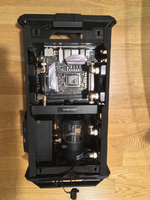
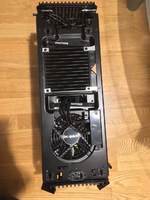
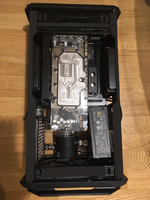
There is still a lot to do. GPU power connectors are a problem. By visual estimate it is not possible to have a fan on the bottom radiator. Otherwise there is not enough clearance for the power connectors. Maybe a slim one. Didn't try this. I wonder how this should work with an AIO, since there must be the same problem.
It will not be possible to replace the mainboard without taking the water loop apart. I think I can live with that. Most probably it will also not be possible to only uninstall the CPU cooler. But there might be a solution, if I route the tube from the front to rear radiator through the "roof" of the case.
I was holding the CPU cooler inside the case to see how it fits. It seemed, as if there was almost no clearance between it and the side panel. This might be a problem for airflow and I am not sure if I stick with the Phanteks cooler or find something more flat.
On the left side of the board, there is the PCIe riser taking away radiator surface. On the right side there is this heatsink, I think - also taking radiator surface away. Well, we will see how temperatures are if I finish the build. Still need to find black tape.



There is still a lot to do. GPU power connectors are a problem. By visual estimate it is not possible to have a fan on the bottom radiator. Otherwise there is not enough clearance for the power connectors. Maybe a slim one. Didn't try this. I wonder how this should work with an AIO, since there must be the same problem.
It will not be possible to replace the mainboard without taking the water loop apart. I think I can live with that. Most probably it will also not be possible to only uninstall the CPU cooler. But there might be a solution, if I route the tube from the front to rear radiator through the "roof" of the case.
I was holding the CPU cooler inside the case to see how it fits. It seemed, as if there was almost no clearance between it and the side panel. This might be a problem for airflow and I am not sure if I stick with the Phanteks cooler or find something more flat.
On the left side of the board, there is the PCIe riser taking away radiator surface. On the right side there is this heatsink, I think - also taking radiator surface away. Well, we will see how temperatures are if I finish the build. Still need to find black tape.
Nice progress. Good job fitting all those radiators in there. If you turn your GPU around (backplate facing out), you may be able to shift the PSU all the way to the left, then shift the GPU all the way to the back, and have room for the bottom front radiator + fan.
Last edited:
einmannbude
Limp Gawd
- Joined
- Aug 16, 2014
- Messages
- 128
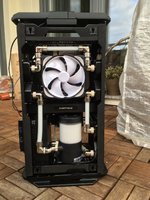

I finished the build. From a visual perspective, this is the best computer I have ever had in my living room. (Living room not in the picture.)
Here is the cutout area again, if any one is interested in a closer look.
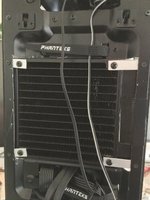
Unfortunately, I already took the system apart. And here is why:
I was running the system with Unigine for maybe 20-30min, when Windows was freezing. At this point on of the CPU cores hit 100°C. GPU was over 60°C I think. Since it was late at night, I went to bed and wanted to try things the next day. I then wanted to mount some fans at the upper radiators at the outside (leaving metal case panels off) just to see, if exhausting air actively through the radiators would result in better CPU temps. Then there was a bang and the whole living room was without power. I tried to turn the system on again and immediately power went off again. I suspect the PSU to be broken, but am not sure about that yet.
Besides that I am thinking about what to do next. Here is a picture of the CPU cooler from the side:
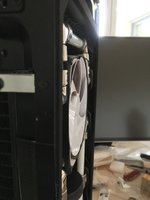
There is almost no clearance between the fan and the side panel. It is clear to me, that this can't work at all. A lower CPU cooler could be an option, but I am unsure about dumping warm air in the upper are of the case is a good idea at all - even if I replaced both upper radiators with fans. In this scenario, I would try to configure the upper are as pull-through. Back fan intake, front fan exhaust. Still thinking that a top-down CPU cooler is a interferer. GPU would be left with 2x 120mm radiators in the bottom area, bottom intake, front exhaust. I would need to install another pump than now. I am not sure about if I should try and build this scenario.
Other thing I thought about was going GPU air cooling and CPU water cooling. Since I utilize the GPU more than the CPU and having TPD of 300W vs. 100W, this feels weird, but it would fit better to what the case was designed for. I was just holding my Accelero III GPU cooler in place, realizing that there is not enough clearance for that. I would need a whole new GPU.
So, I am undecided at the moment. Option three would be reviving my Ncase M1 with 2x240mm radiator config.
Thanks for the update. That’s a lot of work you’ve done there. Sorry it didn’t work out :/ it’s a beautiful setup.
On my end, I decided to take the cpu out of the loop. Here’s the setup:
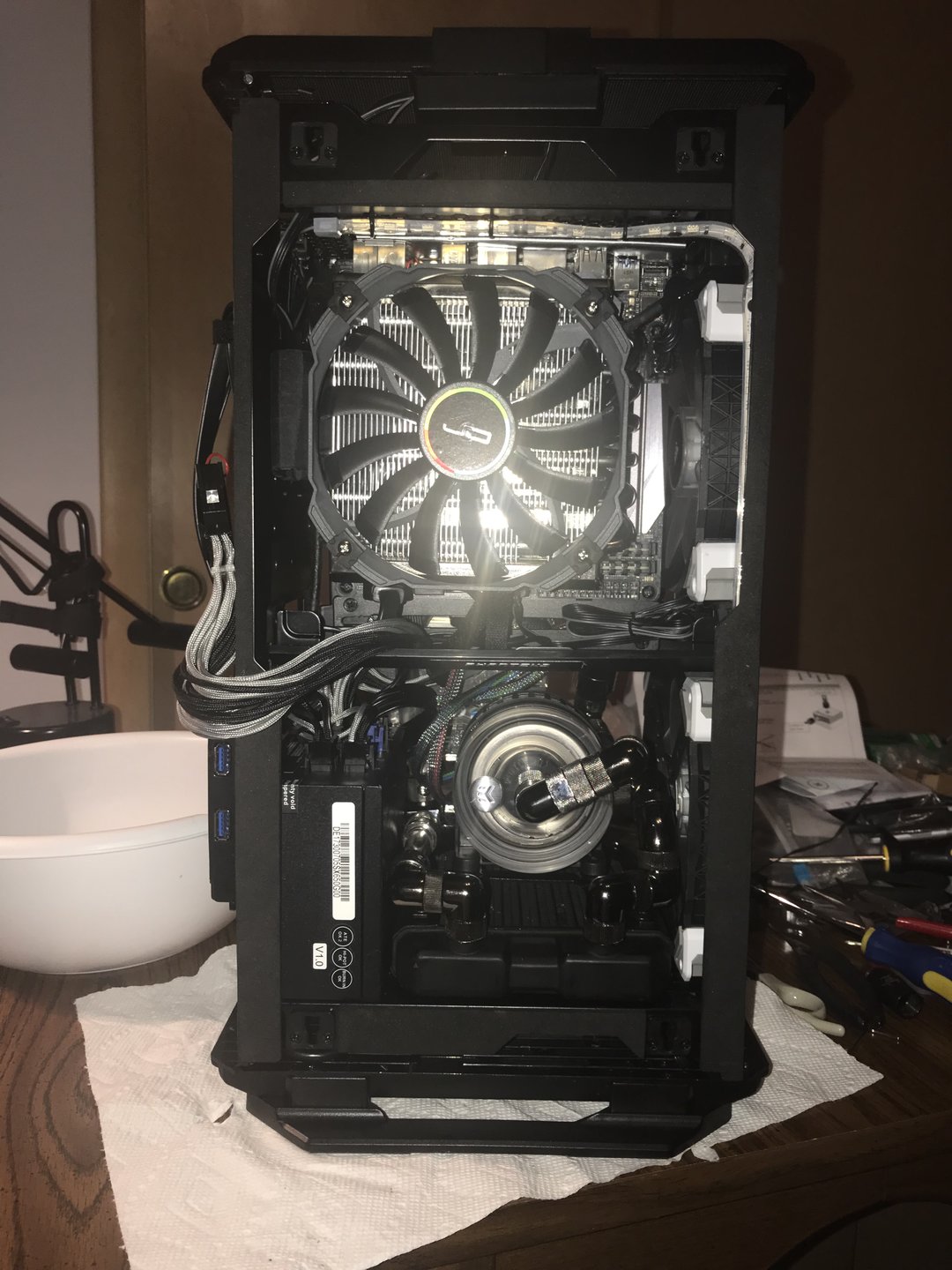
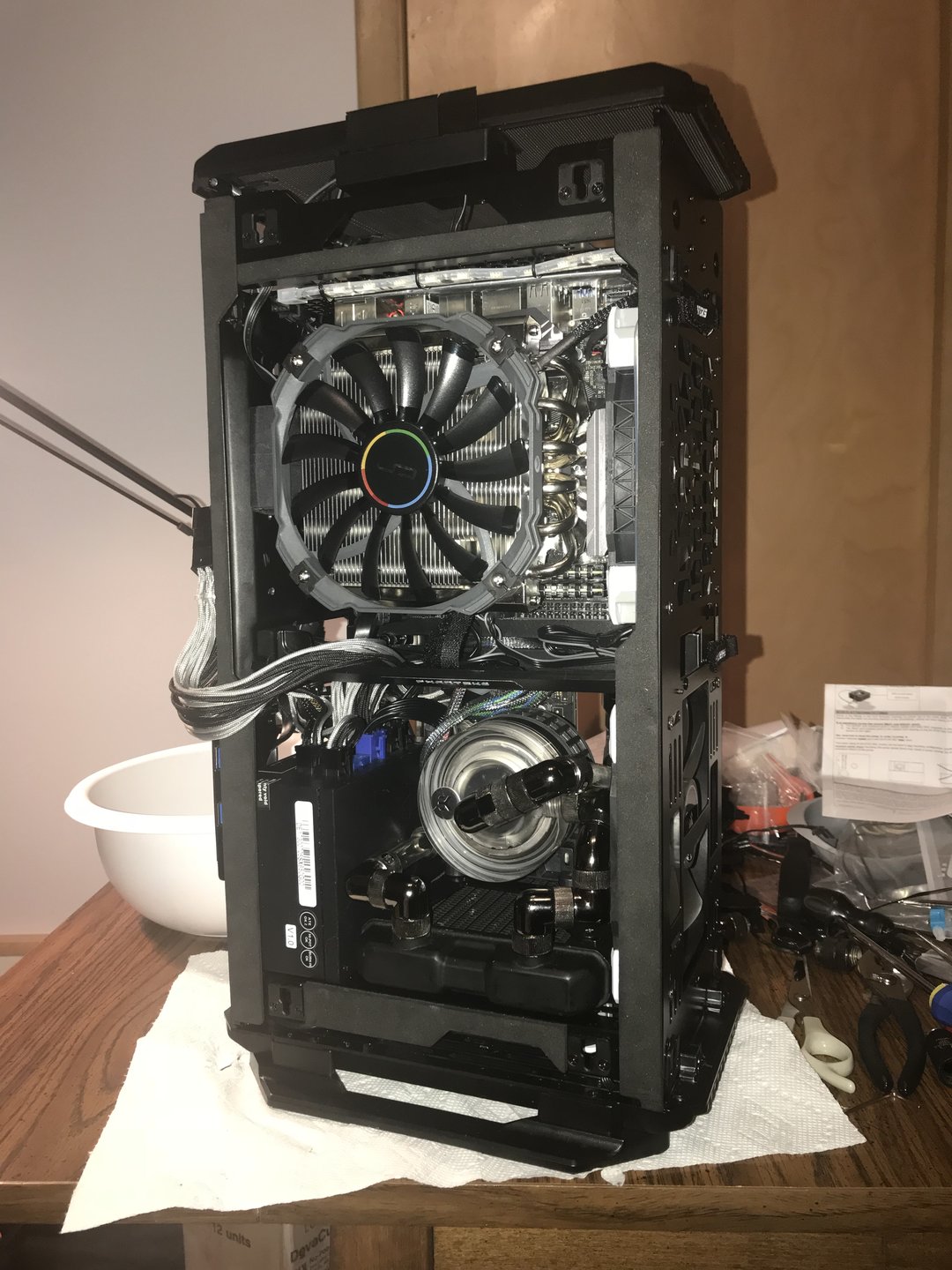
Note the 10mm space between my cpu fan and the glass. I couldn’t get the loop to run correctly, so I gave up.
The cpu cooler is a Thermalright AXP-200 with a Cryorig XT-140.
I threw the NZXT G10 and a Corsair H75 on the GPU and called it a day. I’m bummed that it went from full custom to half custom to air/AIO. The cpu is running warm, so I might switch it to a H55, and the GPU to a H55. Here’s a picture of the current setup late last night:
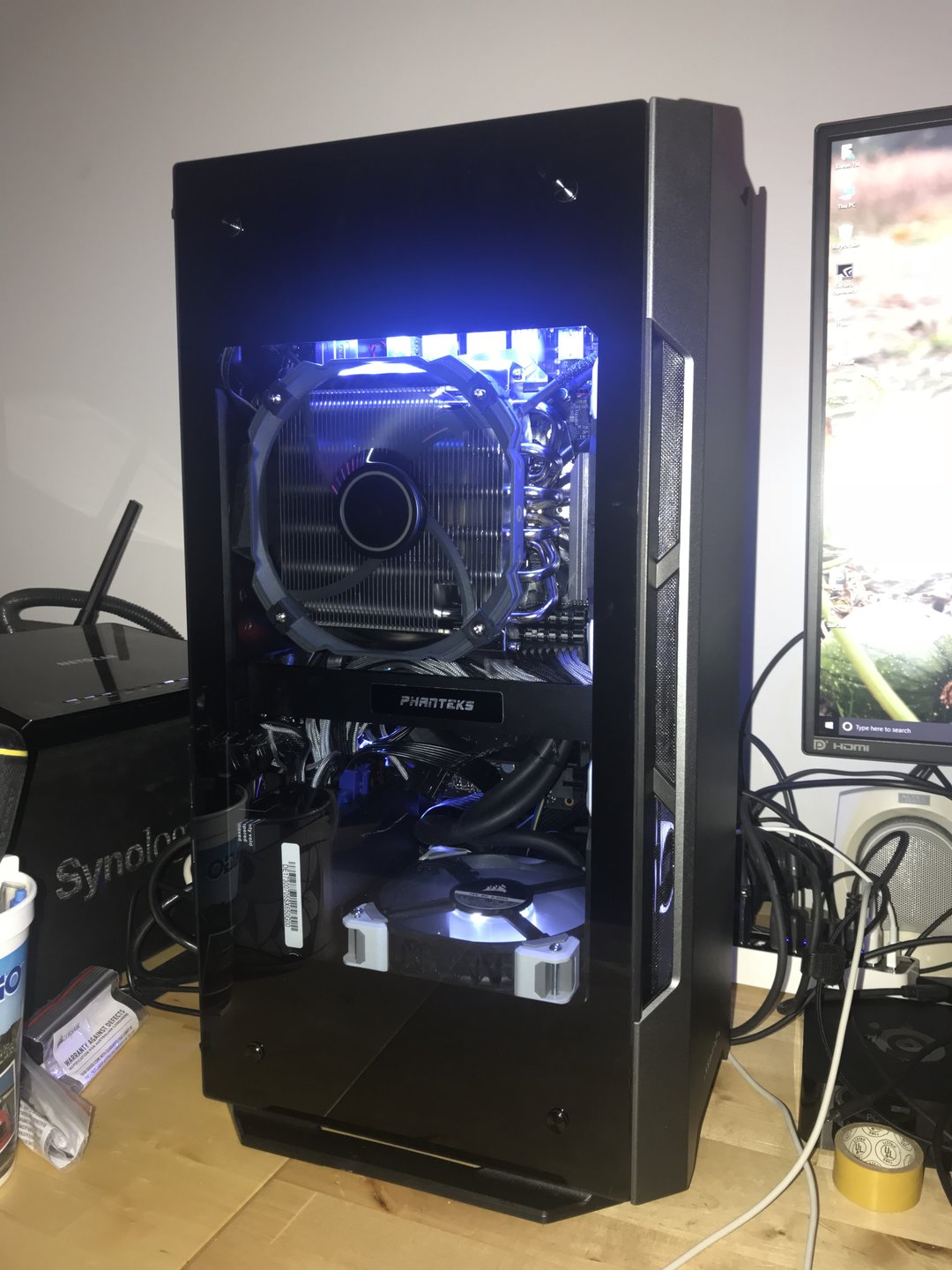
On my end, I decided to take the cpu out of the loop. Here’s the setup:


Note the 10mm space between my cpu fan and the glass. I couldn’t get the loop to run correctly, so I gave up.
The cpu cooler is a Thermalright AXP-200 with a Cryorig XT-140.
I threw the NZXT G10 and a Corsair H75 on the GPU and called it a day. I’m bummed that it went from full custom to half custom to air/AIO. The cpu is running warm, so I might switch it to a H55, and the GPU to a H55. Here’s a picture of the current setup late last night:

Last edited:
QuantumBraced
Gawd
- Joined
- Nov 21, 2015
- Messages
- 594
The Shift is beautiful, but honestly I'm not sure how they managed to make a case that's nearly twice as large as the M1, yet has less functionality and feels just as crammed. Dust management is not great, cable management and accessibility are at best on par with the M1. The only upside is the tempered glass panels that allow you to show off your components -- I guess they prioritized that over size, and if that's your priority then it's a good choice, but if anything else is your priority I think the M1 wins hands down.
einmannbude
Limp Gawd
- Joined
- Aug 16, 2014
- Messages
- 128

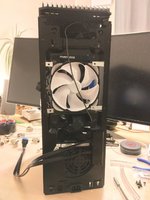
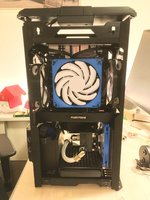
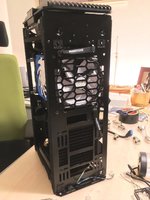
I couldn't help it and tried the upper air-only-for-CPU-chamber and bottom radiator-for GPU-chamber thing. Didn't bleed the system yet. Even hadn't the time to wire up all the fans. I threw in there what I had laying around. If this setup worked, I would change most of the fans for visual reasons. Still searching for a CPU air cooler, that is less than 45mm in height without fan. There are a lot in the 60mm range including a slim fan. Replacing it with an eLoop 25mm fan would increase height to 70mm. Adding the Phanteks Halo would increase it even more. Not Good. And why the hell can't NB manufacture a 140mm eLoop with 25mm height? Those are 29mm, so that they interfere with the PCIe riser cable. Next best are Noctua's fans with horrible color scheme.
![[H]ard|Forum](/styles/hardforum/xenforo/logo_dark.png)


